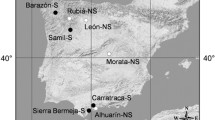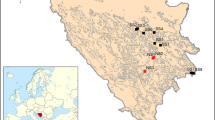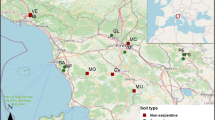Abstract
Background and aims
Phytolacca americana, a globally invasive species, is able to flourish in heavy metal-contaminated habitats. To improve understanding of the adaptive evolutionary mechanisms of plants under heavy metal stress, we investigated key factors contributing to variation in leaf manganese (Mn) content in P. americana.
Methods
Genetic surveys and common garden experiments were conducted simultaneously in an analysis of P. americana populations growing on Mn-contaminated and uncontaminated soil.
Results
Our field survey detected a significant relationship between leaf Mn concentrations in P. americana and concentrations in the soils from which plants were collected. Microsatellite analyses identified low levels of genetic diversity within and between populations; 32 of 39 populations (82 %) were genetically monomorphic. No genetic differentiation was detected between populations from contaminated and uncontaminated soils. Our common garden experiments showed that Mn concentrations in P. americana were related only to the growth habitat, regardless of the origin of the seeds.
Conclusions
Combining the results of our ecological and genetic analyses, we concluded that genetic variation is not likely to be responsible for the wide ecological distribution of P. americana in China. Rather, phenotypic plasticity is probably the major contributor to its successful colonisation of stressful habitats, such as heavy metal-contaminated soils.



Similar content being viewed by others
References
Antonovics J, Bradshaw AD, Turner RG (1971) Heavy metal tolerance in plants. Adv Ecol Res 7:2–85
Armesto JJ, Cheplick GP, McDonnell MJ (1983) Observations on the reproductive biology of Phytolacca americana (Phytolaccaceae). J Torrey Bot Soc 110:380–383
Assunção AGL, Ten Bookum WM, Nelissen HJM, Vooijs R, Schat H, Ernst WHO (2003) A cosegregation analysis of zinc (Zn) accumulation and Zn tolerance in the Zn hyperaccumulator Thlaspi caerulescens. New Phytol 159:383–390
Baker HG (1965) Characteristics and modes of origin of weeds. In: Baker HG, Stebbins GL (eds) The genetics of colonizing species. Academic, New York, pp 147–168
Baker AJM (1987) Metal tolerance. New Phytol 106:93–111
Baker AJM, Brooks R (1989) Terrestrial higher plants which hyperaccumulate metallic elements. A review of their distribution, ecology and phytochemistry. Biorecovery 1:81–126
Baker AJM, Reeves RD, Hajar ASM (1994) Heavy metal accumulation and tolerance in British populations of the metallophyte Thlaspi caerulescens J. & C. Presl (Brassicaceae). New Phytol 127:61–68
Baker AJM, McGrath SP, Reeves RD, Smith JAC (2000) Metal hyperaccumulator plants: a review of the ecology and physiology of a biological resource for phytoremediation of metal-polluted soils. Phytoremediation of contaminated soil and water 8: 85–107
Bekessy SA, Ennos RA, Burgman MA, Newtonc AC, Ades PK (2003) Neutral DNA markers fail to detect genetic divergence in an ecologically important trait. Biol Conserv 110:267–275
Bert V, Bonnin I, Saumitou-Laprade P, de Laguérie P, Petit D (2002) Do Arabidopsis halleri from nonmetallicolous populations accumulate zinc and cadmium more effectively than those from metallicolous populations? New Phytol 155:47–57
Bone E, Farres A (2001) Trends and rates of microevolution in plants. Genetica 112:165–182
Bossdorf O, Richards CL, Pigliucci M (2008) Epigenetics for ecologists. Ecol Lett 11:106–115
Bossdorf O, Arcuri D, Richards CL, Pigliucci M (2010) Experimental alteration of DNA methylation affects the phenotypic plasticity of ecologically relevant traits in Arabidopsis thaliana. Evol Ecol 24:541–553
Brooks RR (1998) Plants that hyperaccumulate heavy metals ed. CAB International
Brooks RR, Reeves RD, Baker AJM (1992) The serpentine vegetation of Goiás State, Brazil. In The Vegetation of Ultramafic (Serpentine) Soils. Intercept Ltd., U.K., pp 67–81
Cappa JJ, Pilon-Smits EAH (2014) Evolutionary aspects of elemental hyperaccumulation. Planta 239:267–275
Conner JK, Hartl DL (2004) A primer of ecological genetics. Sinauer Associates, Sunderland
Dechamps C, Roosens NH, Hotte C, Meerts P (2005) Growth and mineral element composition in two ecotypes of Thlaspi caerulescens on Cd contaminated soil. Plant Soil 273:327–335
Deng J, Liao B, Ye M, Deng D, Lan C, Shu W (2007) The effects of heavy metal pollution on genetic diversity in zinc/cadmium hyperaccumulator Sedum alfredii populations. Plant Soil 297:83–92
Dlugosch KM, Parker IM (2008) Founding events in species invasions: genetic variation, adaptive evolution, and the role of multiple introductions. Mol Ecol 17:431–449
Epstein E, Bloom AJ (2005) Mineral nutrition of plants: principles and perspectives, 2nd edn. Sinauer Associates, USA
Ernst WHO (2006) Evolution of metal tolerance in higher plants. For Snow Landsc Res 80:251–274
Escarré J, Lefèbvre C, Gruber W, Leblanc M, Lepart J, Rivière Y, Delay B (2000) Zinc and cadmium hyperaccumulation by Thlaspi caerulescens from metalliferous and nonmetalliferous sites in the Mediterranean area: implications for phytoremediation. New Phytol 145:429–437
Evanno G, Regnaut S, Goudet J (2005) Detecting the number of clusters of individuals using the software STRUCTURE: a simulation study. Mol Ecol 14:2611–2620
Excoffier L, Lischer HEL (2010) Arlequin suite ver 3.5: a new series of programs to perform population genetics analyses under Linux and Windows. Mol Ecol Resour 10:564–567
Fernando DR, Woodrow IE, Bakkaus EJ, Collins RN, Bakerm AJM, Batianoff GN (2007) Variability of Mn hyperaccumulation in the Australian rainforest tree Gossia bidwillii (Myrtaceae). Plant Soil 293:145–152
Gao L, Peng KJ, Xia Y, Wang GP, Niu LY, Lian CL, Shen ZG (2013) Cadmium and manganese accumulation in Phytolacca americana L. and the roles of non-protein thiols and organic acids. Int J Phytoremediat 15:307–319
Geng YP, Pan XY, Xu CY, Zhang WJ, Li B, Chen JK, Lu BR, Song ZP (2007) Phenotypic plasticity rather than locally adapted ecotypes allows the invasive alligator weed to colonize a wide range of habitats. Biol Invasions 9:245–256
Jiménez‐Ambriz G, Petit C, Bourrié I, Dubois S, Olivieri I, Ronce O (2007) Life history variation in the heavy metal tolerant plant Thlaspi caerulescens growing in a network of contaminated and noncontaminated sites in southern France: role of gene flow, selection and phenotypic plasticity. New Phytol 173:199–215
Kalinowski ST, Taper ML, Marshall TC (2007) Revising how the computer program CERVUS accommodates genotyping error increases success in paternity assignment. Mol Ecol 16:1099–1106
Kilvitis HJ, Alvarez M, Foust CM, Schrey AW, Robertson M, Richards CL (2014) Ecological epigenetics. In: Landry CR, Aubin-Horth N (eds) Ecological genomics. Springer, New York, pp 191–210
Krämer U (2010) Metal hyperaccumulation in plants. Annu Rev Plant Biol 61:517–534
Kruckeberg AR (1967) Ecotypic response to ultramafic soils by some plant species of northwestern United States. Brittonia 19:133–151
Kuta E, Jędrzejczyk-Korycińska M, Cieślak E, Rostański A, Szczepaniak M, Migdałek G, Wąsowicz P, Suda J, Combik M, Słomka A (2014) Morphological versus genetic diversity of Viola reichenbachiana and V. riviniana (sect. Viola, Violaceae) from soils differing in heavy metal content. Plant Biol 16:925–934
Lefèbvre C, Vernet P (1990) Microevolutionary processes on contaminated deposits. In: Shaw J (ed) Heavy metal tolerance in plants: evolutionary aspects. CRC Press, Boca Raton, pp 286–297
Lian CL, Abdul Wadud M, Geng Q, Shimatani K, Hogetsu T (2006) An improved technique for isolating codominant compound microsatellite markers. J Plant Res 119:415–417
Lichtenthaler HK, Wellburn AR (1983) Determinations of total carotenoids and chlorophylls a and b of leaf extracts in different solvents. Biochem Soc Trans 603:591–593
Liu XQ, Peng KJ, Wang AG, Lian CL, Shen ZG (2010) Cadmium accumulation and distribution in populations of Phytolacca americana L. and the role of transpiration. Chemosphere 78:1136–1141
Macnair MR (2002) Within and between population genetic variation for zinc accumulation in Arabidopsis halleri. New Phytol 155:59–66
Macnair MR (2003) The hyperaccumulation of metals by plants. Adv Bot Res 40:63–105
Macnair MR, Bert V, Huitson SB, Saumitou-Laprade P, Petit D (1999) Zinc tolerance and hyperaccumulation are genetically independent characters. P Roy Soc B-Biol Sci 266:2175–2179
Marschner H (2011) Marschner's mineral nutrition of higher plants. Academic Press
McGrath SP, Zhao J, Lombi E (2002) Phytoremediation of metals, metalloids, and radionuclides. Adv Agron 75:1–56
McKay JK, Latta RG (2002) Adaptive population divergence: markers, QTL and traits. Trends Ecol Evol 17:285–291
McKay JK, Bishop JG, Lin JZ, Richards JH, Sala A, Mitchell-Olds T (2001) Local adaptation across a climatic gradient despite small effective population size in the rare sapphire rockcress. Proc R Soc Lond B 268:1715–1721
Mengoni A, Gonnelli C, Galardi F, Gabbrielli R, Bazzicalupo M (2000) Genetic diversity and heavy metal tolerance in populations of Silene paradoxa L. (Caryophyllaceae): a random amplified polymorphic DNA analysis. Mol Ecol 9:1319–1324
Mengoni A, Barabesi C, Gonnelli C, Galardi F, Gabbrielli R, Bazzicalupo M (2001) Genetic diversity of heavy metal‐tolerant populations in Silene paradoxa L. (Caryophyllaceae): a chloroplast microsatellite analysis. Mol Ecol 10:1909–1916
Meyer CL, Kostecka AA, Saumito-Laprade P, Créach A, Castric V, Pauwels M, Frérot H (2010) Variability of zinc tolerance among and within populations of the pseudometallophyte species Arabidopsis halleri and possible role of directional selection. New Phytol 185:130–142
Muller LAH, Lambaerts M, Vangronsveld J, Colpaert JV (2004) AFLP-based assessment of the effects of environmental heavy metal pollution on the genetic structure of pioneer populations of Suillus luteus. New Phytol 164:297–303
Orrock JL (2005) The effect of gut passage by two species of avian frugivore on seeds of pokeweed, Phytolacca americana. Can J Bot 83:427–431
Pauwels M, Saumitou-Laprade P, Holl AC, Petit D, Bonnin I (2005) Multiple origin of metallicolous populations of the pseudometallophyte Arabidopsis halleri (Brassicaceae) in central Europe: the cpDNA testimony. Mol Ecol 14:4403–4414
PCD (Pollution Control Department, Thailand) (1995) Notification of National Environmental Board No. 10, B.E 2538 (1995) under the Enhancement and Conservation of National Environmental Quality Act B.E.2535 (1992), published in the Royal Government Gazette No. 112 Part 52 dated May 25, B.E.2538. http://www.pcd.go.th/infoserv/en reg std airsnd01.html
Peakall R, Smouse PE (2012) GenAlEx 6.5: genetic analysis in Excel. Population genetic software for teaching and research—an update. Bioinformatics 28:2537–2539
Peng K, Li X, Luo C, Shen Z (2006) Vegetation composition and heavy metal uptake by wild plants at three contaminated sites in Xiangxi area, China. J Environ Sci Health Pt A 41:65–76
Peng K, Luo C, You W, Lian C, Li X, Shen Z (2008) Manganese uptake and interactions with cadmium in the hyperaccumulator-Phytolacca americana L. J Hazard Mater 154:674–681
Pilon-Smits E (2005) Phytoremediation. Annu Rev Plant Biol 56:15–39
Pollard AJ, Powell KD, Harper FA, Smith JAC (2002) The genetic basis of metal hyperaccumulation in plants. Crit Rev Plant Sci 21:539–566
Pollard AJ, Stewart HL, Roberson CB (2009) Manganese hyperaccumulation in Phytolacca americana L. from the Southeastern United States. Northeast Nat 16:155–162
Pollard AJ, Reeves RD, Baker AJM (2014) Facultative hyperaccumulation of heavy metals and metalloids. Plant Sci 217:8–17
Pritchard JK, Wen X, Falush D (2010) Documentation for Structure software. Version 2.3. University of Chicago, Chicago. Available at http://pritch.bsd.uchicago.edu/structure.html. Accessed 01 Dec 2014
Reeves RD (2003) Tropical hyperaccumulators of metals and their potential for phytoextraction. Plant Soil 249:57–65
Reeves RD, Baker AJM (2000) Metal-accumulating plants. In: RaskinI EBD (ed) Phytoremediation of toxic metals: using plants to clean up the environment. Wiley, New York, pp 193–229
Reznick DN, Ghalambor CK (2001) The population ecology of contemporary adaptations: what empirical studies reveal about the conditions that promote adaptive evolution. Genetica 112:183–198
Richards CL, Walls RL, Bailey JP, Parameswaran R, George T, Pigliucci M (2008) Plasticity in salt tolerance traits allows for invasion of novel habitat by Japanese knotweed sl (Fallopia japonica and F. × bohemica, Polygonaceae). Am J Bot 95:931–942
Richards CL, Schrey AW, Pigliucci M (2012) Invasion of diverse habitats by few Japanese knotweed genotypes is correlated with epigenetic differentiation. Ecol Lett 15:1016–1025
Scoville AG, Barnett LL, Bodbyl-Roels S, Kelly JK, Hileman LC (2011) Differential regulation of a MYB transcription factor is correlated with transgenerational epigenetic inheritance of trichome density in Mimulus guttatus. New Phytol 191:251–263
Tie BQ, Yuan M, Tang MZ (2005) Phytolacca americana L.: a new manganese accumulator plant. J Agro Environ Sci 24:340–341
Van der Ent A, Baker AJM, Reeves RD, Pollard AJ, Schat H (2013) Hyperaccumulators of metal and metalloid trace elements: facts and fiction. Plant Soil 362:319–334
Verbruggen N, Hermans C, Schat H (2009) Molecular mechanisms of metal hyperaccumulation in plants. New Phytol 181:759–776
Ward SM, Reid SD, Harrington J, Sutton J, Beck KG (2008) Genetic variation in invasive populations of Yellow Toadflax (Linaria vulgaris) in the western United States. Weed Sci 56:394–399
Williams JL, Auge H, Maron JL (2008) Different gardens, different results: native and introduced populations exhibit contrasting phenotypes across common gardens. Oecologia 157:239–248
Wójcik M, Dresler S, Jawor E, Kowalczykb K, Tukiendorf A (2013) Morphological, physiological, and genetic variation between metallicolous and nonmetallicolous populations of Dianthus carthusianorum. Chemosphere 90:1249–1257
Compliance with ethical standards
Funding
This work was financially supported by the National Natural Science Foundation of China (31400328), the Natural Science Foundation of Jiangsu Province (BK20140697), China’s Postdoctoral Science Foundation (2014 M560428) and Postdoctoral Science Foundation of Jiangsu Province (1402155C).
Conflict of interest
The authors declare that they have no competing interests.
Author information
Authors and Affiliations
Corresponding authors
Additional information
Responsible Editor: Hans Lambers.
Rights and permissions
About this article
Cite this article
Chen, C., Zhang, H., Wang, A. et al. Phenotypic plasticity accounts for most of the variation in leaf manganese concentrations in Phytolacca americana growing in manganese-contaminated environments. Plant Soil 396, 215–227 (2015). https://doi.org/10.1007/s11104-015-2581-7
Received:
Accepted:
Published:
Issue Date:
DOI: https://doi.org/10.1007/s11104-015-2581-7




